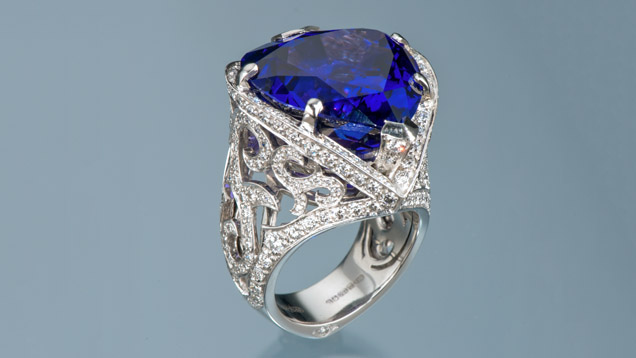Tanzanite Description
Tanzanite is the violet blue to blue violet variety of the mineral zoisite. It is mined commercially only in one area of the world: the Merelani Hills of Tanzania, which is where it gets its name.

Top-quality tanzanite can be violetish blue --similar to a fine sapphire color --or a unique, predominately violet hue all its own. Some stones might also appear more purplish depending on how the cutter chooses to orient the fashioned gem. Both the violet and blue pleochroic colors are readily visible in a fashioned stone when it is gently rocked and tilted. This means that every tanzanite is a blend of these pleochroic colors. The exact face-up color depends on the inherent color of the original rough, its size, the pleochroic colors the cutter favors when they orient the fashioned stone, and the light the finished gem is viewed under. Cool lighting --like daylight equivalent fluorescent --will emphasize tanzanite's blue, while warm lighting --like incandescent --will make it appear more violet-to-purple.
Just like other colored gemstones, vivid strongly-colored tanzanites are highly sought after. Lighter toned pastel hues are more plentiful and affordable than vivid colors and have a subtle appeal of their own.


When blue-to-violet crystals were first discovered in Tanzania in the 1960s, no one
was quite sure what the new crystals were. Careful gemological study determined
that they were a transparent variety of zoisite, and the gem came to be known as
tanzanite. - Jeff Scovil, courtesy Marcus Budil Collection
Tanzanite's appearance is influenced greatly by its pleochroism, which is the ability of a gemstone to show different colors when viewed in different crystal directions. Tanzanite's pleochroism was documented in scientific papers not long after its discovery. In 1969, American Mineralogist described the gem's pleochroic colors as `red-violet, deep blue, and yellow green.' Today, most gems are heat treated, which removes or reduces the yellow green or brownish pleochroic color, maximizing the blue and violet. was quite sure what the new crystals were. Careful gemological study determined
that they were a transparent variety of zoisite, and the gem came to be known as
tanzanite. - Jeff Scovil, courtesy Marcus Budil Collection
Top-quality tanzanite can be violetish blue --similar to a fine sapphire color --or a unique, predominately violet hue all its own. Some stones might also appear more purplish depending on how the cutter chooses to orient the fashioned gem. Both the violet and blue pleochroic colors are readily visible in a fashioned stone when it is gently rocked and tilted. This means that every tanzanite is a blend of these pleochroic colors. The exact face-up color depends on the inherent color of the original rough, its size, the pleochroic colors the cutter favors when they orient the fashioned stone, and the light the finished gem is viewed under. Cool lighting --like daylight equivalent fluorescent --will emphasize tanzanite's blue, while warm lighting --like incandescent --will make it appear more violet-to-purple.
Just like other colored gemstones, vivid strongly-colored tanzanites are highly sought after. Lighter toned pastel hues are more plentiful and affordable than vivid colors and have a subtle appeal of their own.

This 29.22-carat tanzanite has a deep violetish blue color sometimes described as midnight blue. - Courtesy Tanzanite Foundation ™



